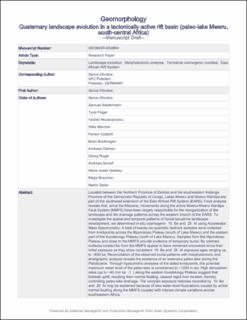| dc.contributor.author | Olivotos, Spiros | |
| dc.contributor.author | Niedermann, Samuel | |
| dc.contributor.author | Flügel, Tyrel | |
| dc.contributor.author | Mouslopoulou, Vasiliki | |
| dc.contributor.author | Merchel, Silke | |
| dc.contributor.author | Cotterill, Fenton | |
| dc.contributor.author | Bookhagen, Bodo | |
| dc.contributor.author | Gärtner, Andreas | |
| dc.contributor.author | Rugel, Georg | |
| dc.contributor.author | Scharf, Andreas | |
| dc.contributor.author | Nadeau, Marie-Josée | |
| dc.contributor.author | Braucher, Régis | |
| dc.contributor.author | Seiler, Martin | |
| dc.date.accessioned | 2022-02-22T15:47:01Z | |
| dc.date.available | 2022-02-22T15:47:01Z | |
| dc.date.created | 2021-08-05T14:13:01Z | |
| dc.date.issued | 2021 | |
| dc.identifier.citation | Geomorphology. 2021, 381 1-22. | en_US |
| dc.identifier.issn | 0169-555X | |
| dc.identifier.uri | https://hdl.handle.net/11250/2980842 | |
| dc.description.abstract | Located between the Northern Province of Zambia and the southeastern Katanga Province of the Democratic Republic of Congo, Lakes Mweru and Mweru Wantipa are part of the southwest extension of the East African Rift System (EARS). Fault analysis reveals that, since the Miocene, movements along the active Mweru-Mweru Wantipa Fault System (MMFS) have been largely responsible for the reorganization of the landscape and the drainage patterns across the western branch of the EARS. To investigate the spatial and temporal patterns of fluvial-lacustrine landscape development, we determined in-situ cosmogenic 10Be and 26Al using Accelerator Mass Spectrometry. A total of twenty-six quartzitic bedrock samples were collected from knickpoints across the Mporokoso Plateau (south of Lake Mweru) and the eastern part of the Kundelungu Plateau (north of Lake Mweru). Samples from the Mporokoso Plateau and close to the MMFS provide evidence of temporary burial. By contrast, surfaces located far from the MMFS appear to have remained uncovered since their initial exposure as they show consistent 10Be and 26Al exposure ages ranging up to ~830 ka. Reconciliation of the observed burial patterns with morphotectonic and stratigraphic analysis reveals the existence of an extensive paleo-lake during the Pleistocene. Through hypsometric analyses of the dated knickpoints, the potential maximum water level of the paleo-lake is constrained to ~1200 m asl. High denudation rates (up to ~40 mm ka−1) along the eastern Kundelungu Plateau suggest that footwall uplift, resulting from normal faulting, caused rapid river incision, thereby controlling paleo-lake drainage. The complex exposure histories recorded by 10Be and 26Al may be explained because of lake water-level fluctuations caused by active normal faulting along the MMFS coupled with intense climate variations across southeastern Africa. | en_US |
| dc.language.iso | eng | en_US |
| dc.publisher | Elsevier | en_US |
| dc.rights | Attribution-NonCommercial-NoDerivatives 4.0 Internasjonal | * |
| dc.rights.uri | http://creativecommons.org/licenses/by-nc-nd/4.0/deed.no | * |
| dc.title | Quaternary landscape evolution in a tectonically active rift basin (paleo-lake Mweru, south-central Africa) | en_US |
| dc.type | Peer reviewed | en_US |
| dc.type | Journal article | en_US |
| dc.description.version | acceptedVersion | en_US |
| dc.rights.holder | This is the authors' accepted manuscript to an article published by Elsevier. Locked until 26/2-2023 due to copyright restrictions. The AAM is made available under the CC-BY-NC-ND 4.0 license http://creativecommons.org/licenses/by-nc-nd/4.0/ | en_US |
| dc.source.pagenumber | 1-22 | en_US |
| dc.source.volume | 381 | en_US |
| dc.source.journal | Geomorphology | en_US |
| dc.identifier.doi | 10.1016/j.geomorph.2021.107669 | |
| dc.identifier.cristin | 1924158 | |
| cristin.ispublished | true | |
| cristin.fulltext | postprint | |
| cristin.qualitycode | 2 | |

